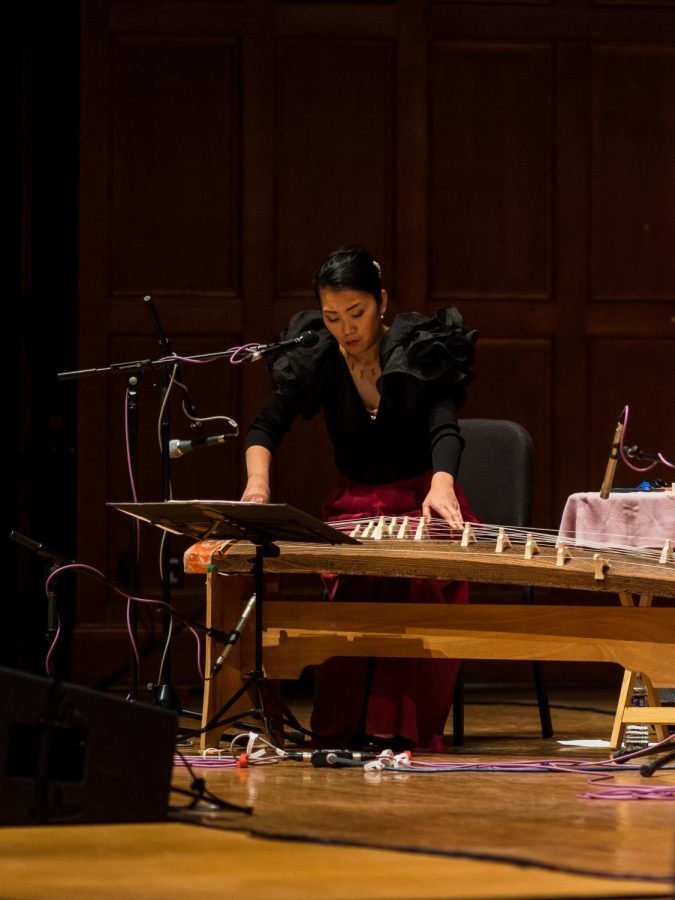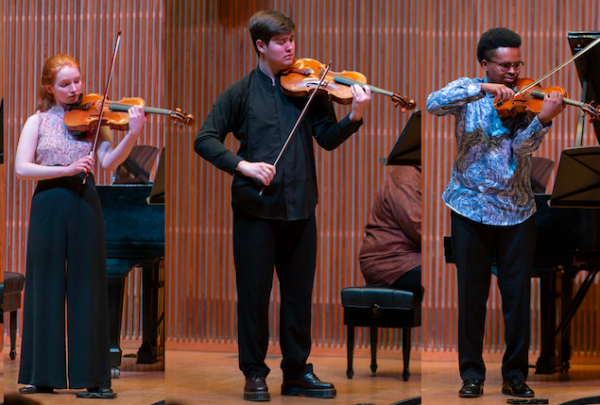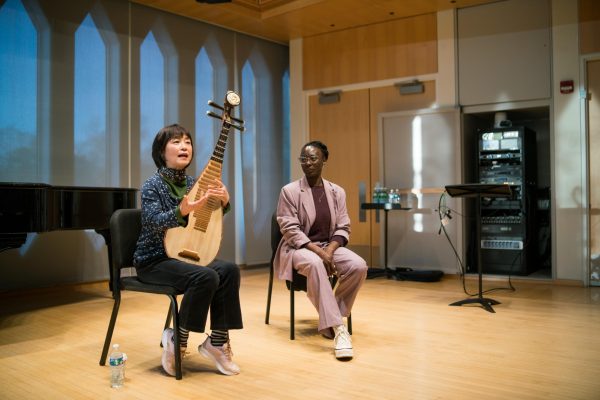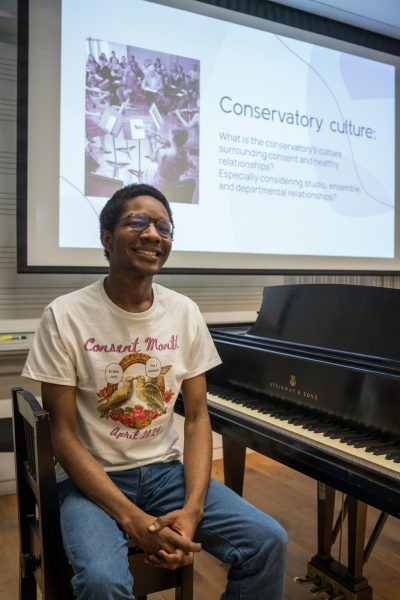Students Perform Traditional Music in Conservatory Despite Lack of Resources
The Kenny Endo Contemporary Music Ensemble featured a koto player at their concert in Finney Chapel last spring.
Within the Conservatory, students are limited in study and access to a specific set of musical instruments that draw mainly from the Western classical tradition. This causes a lack of spaces for students wishing to practice instruments and music that are directly linked to their heritage and culture. How, then, do Conservatory students create and find spaces on campus to practice traditional music?
Spaces within the Conservatory do exist for students who want to perform traditional music from around the world on their primary instruments. Second-year Jazz Voice major Aanya Sengupta, for example, has found a community where she can practice traditional music through the Performance and Improvisation Ensemble.
“The goal of the program is to really bring together musicians and practitioners that come from different traditions and musical backgrounds to make music together — to make art together,” Sengupta said.
The ensembles vary in size and instrumentation, as students from both the Jazz and classical departments collaborate in these spaces. This unconventional mix of instruments presents a unique challenge for students, requiring them to figure out not only the larger orchestration but also how to adapt one’s instrument individually to the sound or technique of the traditional music they are working with.
“It’s about being a part of this other music and just adapting to the music you’re playing,” Sengupta said. “That comes from paying attention to the tradition that it came from and seeing what you can do with your instrument — exploring the limits of the instrument a lot.”
Sengupta stressed the importance of learning about the history and culture of the musical tradition students are working with in order to approach the music respectfully, especially considering the biases of our musical institution.
“There’s this attitude toward music from China, from India — where I’m from — from Latin America that is very exoticized, which is the value of the PI program,” Sengupta said. “This music becomes the norm, and it becomes just as worthy of study as the music in the classical department[s], in the Jazz department.”
Sengupta grew up learning Hindustani classical music before starting jazz voice lessons in high school. She communicated her appreciation for the PI ensembles as a space to reconnect with the music she studied growing up as well as the many other traditions she gets to interact with.
“To this day, if there’s one regret I have, it’s that I wish I had kept studying Indian music and given it the respect then that I give it now,” Sengupta said.
For students who don’t see their traditional music represented within the Conservatory, they create their own spaces. Second-year Bass Performance major Emily Bergin grew up playing traditional Irish music on a multitude of instruments including the tin whistle, accordion, Irish flute, harmonica, and mandolin. This semester, she is offering an Irish music ExCo.
“I’ve played Irish music since I was in second grade,” Bergin said. “I wanted to continue passing that on to other people because it’s not an extremely common thing; not a lot of people know a whole bunch about it, but there’s a good amount of interest for it.”
Because Irish traditional music is orally transmitted, the melodies and forms are quite accessible to less experienced musicians. Although the Conservatory does not provide Bergin’s ExCo with instruments, she emphasized that Irish traditional music can be played on any instrument, and her students come to class with whatever they have.
Bergin also found a community for her passion within the Oberlin Contra Dance Club, a club for American folk dance with music provided by student folk musicians, and the Oberlin Folk Music Club, both of which are student-run groups that span both the College and Conservatory. These groups often hold jam sessions and connect students on campus who play all styles of folk music.
Like Bergin, second-year Viola Performance major and composer Katia Rumin experiments with playing and composing folk music at Oberlin through the Folk Music Club and Contra Dance Club. Because folk music differs technically from classical music and comes from an oral tradition, writing classical music with folk influences or just notating folk music itself presents challenges.
“I want to do this thing that only comes up in folk music and I’m like, ‘Oh, how the heck do I notate this?’ because in folk music we mostly learn things by ear,” Rumin said.
When asked if the Composition department was well-equipped to instruct students like Rumin who face these notational problems in their compositions, Rumin responded with insightful criticism.
“This school does not really have a real support for folk music, and I really wish this school would do more to get their students to play folk music, because I think in the 21st century, we as musicians could be called to do anything, like playing in a folk band,” Rumin said. “I think it’s just important that we have these skills.”
She reiterated this concern in regard to the lack of educational and professional opportunities in the Conservatory to perform and study folk music, as well as access to mentorship and gigs.
“I just wish the Conservatory would give more support to people who play folk music and offer more connections, because we have to do this all by ourselves right now, you know?” Rumin said.
Second-year Violin Performance major Laoise Matsumoto started playing the koto, a six-foot-long wooden traditional Japanese stringed instrument, in high school, but spent much of her life surrounded by traditional Japanese music at her Japanese dance school, where she had been taking classes since she was two. Although the Conservatory offers no course of study for the koto, Matsumoto is committed to continuing her practice of this instrument, storing the large instrument in her dorm and taking Zoom lessons from a professional koto player in New York. She mentioned that because of the instrument’s large size — and the limited sizes of practice rooms and lockers — she never transports her koto to the Conservatory building.
Even if Matsumoto could bring her koto to the Conservatory, there is virtually no community for traditional Japanese music within its walls. Aside from Oberlin College Taiko, a student group that performs traditional Japanese drumming, Matsumoto could not name a single space, ensemble, or professor for students who play traditional Japanese instruments in the Conservatory, which makes playing the koto, an instrument most often performed with other kotos, quite isolating.
Echoing the difficulty faced by other Conservatory students who play traditional music in addition to their Conservatory studies, Matsumoto commented that she struggles to prioritize her koto.
“It’s not my primary instrument, … and I think I’m okay with that, but it’s also hard because my professor here actually doesn’t know I play a different instrument,” Matsumoto said. “I try to do a couple hours a week, but sometimes I can’t and that’s okay.”
While the Conservatory doesn’t have a community for Japanese music, it does offer opportunities for students to attend traditional music performances on campus through its concert series. Matsumoto recounted her experience watching a Japanese music ensemble, the Kenny Endo Contemporary Music Ensemble, which came to perform at Finney Chapel last spring.
“It is definitely nice that the Conservatory does bring artists, at least,” Matsumoto said. “There was one koto player … it wasn’t with other Western instruments, it was with other traditional instruments. I thought it was cool and I wish I could do that sometimes.”





